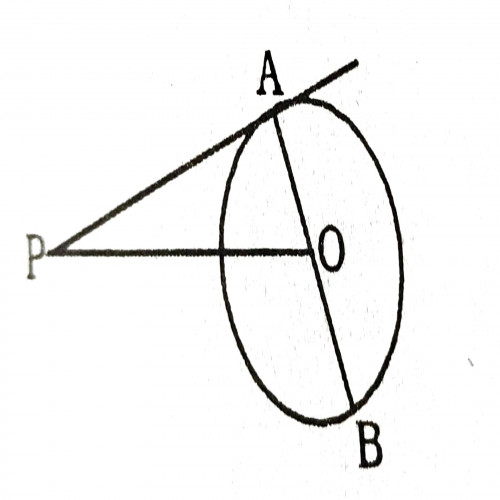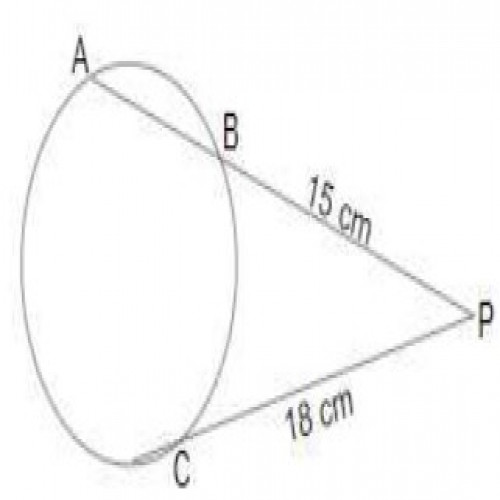objective Ques (149 results)
1)In the figure, PA is a tangent from an external point P to the circle with centre O. If \(\angle POB = 110 ^{\circ}\), then measure of \(\angle APO\) is:
SSC CGL 2020
\(20 ^{\circ}\)
PA is a tangent
\(\angle POA =180^{\circ}- 110 ^{\circ}=70^{\circ}\)
\(\angle PAO =90^{\circ}\)
\(\angle APO =180^{\circ}- 70 ^{\circ}-90^{\circ}=20^{\circ}\)
Class 10 Maths2)If angle of sector is 60°, radius is 3.5 cm then length of the arc is
3.66 cm
SSC CGL 20193)Chord AB of a circle is produced to a point P, and is a point on the circle such that PC is a tangent to the circle. If PC = 18 cm, and BP = 15 cm, then AB is equal to:
6.6 cm
By the property,
\(PC^2 = PA \times PB;\)
\((18)^2 = PA \times 15;\)
PA = 324/15 = 21.6 cm;
AB = PA - PB = 21.6 - 15 = 6.6 cm

SSC CGL 20194)Two parallel chords on the same side of the centre of a circle are 12 cm and 20 cm long and the radius of the circle is \(5\sqrt{13}cm\). What is the distance (in cm) between the chords?
2
SSC CGL 20195)A circle touches the side BC of \(\triangle ABC\) at D and AB and AC are produced to E and F, respectively. If AB = 10 cm, AC = 8.6 cm and BC =6.4 cm, then BE =?
2.5 cm
SSC CGL 20196)In circle with centre O, AC and BD are two chords. AC and BD meet at E when produced. If AB is the diameter and \(\angle AEB=68^0\), then the measure of \(\angle DOC\) is :
\(44^0\)
SSC CGL 20197)In a circle, AB and DC are two chords. When AB and DC are produced, they meet at P. If PC = 5.6 cm, PB = 6.3 cm and AB = 7.7 cm, then the length of CD is:
10.15 cm.
SSC CGL 20208)In a circle, chords PQ and TS are produced to meet at R. If RQ = 14.4 cm, PQ = 11.2 cm, and SR = 12.8 cm, then the length of chord TS is:
16 cm
RQ X PR = RS X TR; 14.4 X (14.4+11.2) = 12.8 X TR; TR = \({14.4\times25.6\over12.8}=28.8 cm\) ; TS = TR - SR = (28.8 - 12.8) cm = 16 cm

SSC CGL 20209)From an external point P, a tangent PQ is drawn to a circle, with the centre O, touching the circle at Q. If the distance of P from the centre is 13 cm and length of the tangent PQ is 12 cm, then the radius of the circle is:
5 cm
\triangle OPQ is a right angle triangle because \(\angle Q = 90^0\),
By Pythagoras,
\((OQ)^2 + (PQ)^2 = (OP)^2\);
\((OQ)^2 = (13)^2 - (12)^2\);
\((OQ)^2\) = 169 - 144;
\((OQ)^2\) = 25;
OQ = 5 cm.

SSC CGL 202010)In a circle, AB is a the diameter and CD is a chord. AB and CD produced meet at a point P, outside the circle. If PD = 15.3 cm, CD = 11.9 cm and AP = 30.6 cm,then the radius of the circle is is:
8.5 cm
From the property,
\(PA \times PB = PC \times PD\);
\(30.6 \times PB = (PD + CD) \times 15.3\);
\(30.6 \times PB = (15.3 + 11.9) \times 15.3\);
\(30.6 \times PB = 27.2 \times 15.3\);
PB = 416.16/30.6 = 13.6 cm;
Diameter (AB) = PA - PB = 30.6 - 13.6 = 17 cm;
Radius = AB/2 = 17/2 = 8.5 cm
